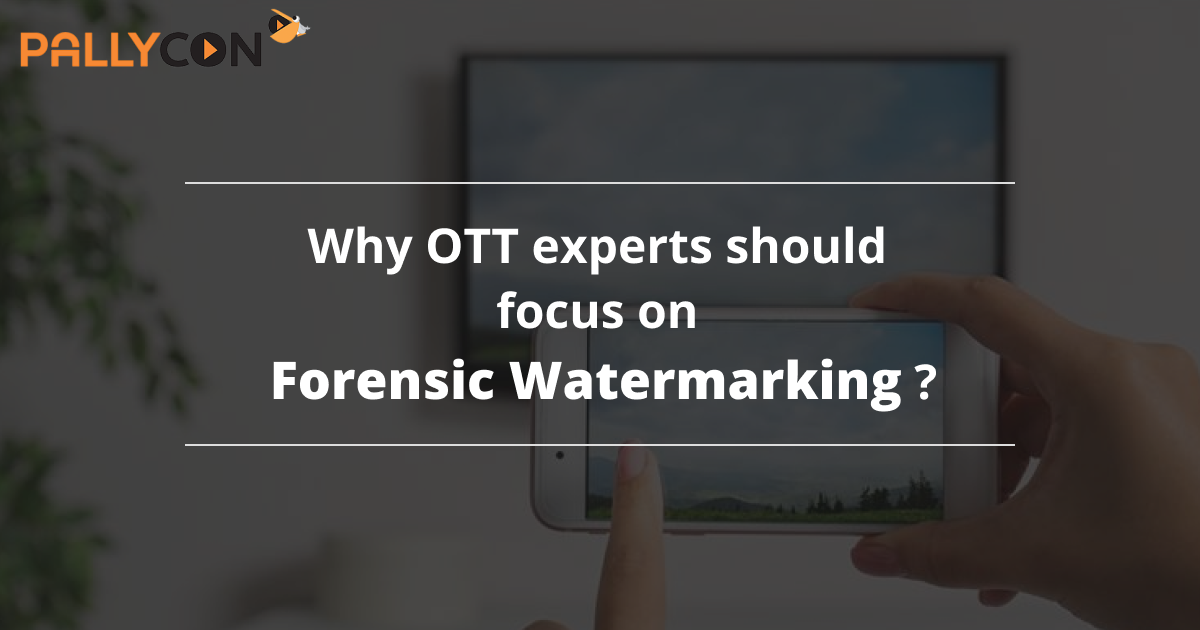
Why OTT experts should focus on forensic watermarking
Introduction
As the OTT space is seeing a major jump in terms of consumption and subscriptions spurred on by the pandemic, content piracy is also rearing its ugly head with gangs of scammers waiting to make some quick bucks. Crores of money are being lost every year due to illegitimate consumption and distribution of video content. According to a 2019 report by Parks Associate, the loss to businesses owing to piracy is estimated to reach $12.5Bn by 2024. This becomes a major issue for the entertainment chain including content creators, owners and distributors. Especially when it comes to content that is being highly anticipated, an incident of piracy can severely impact all the parties involved. And thanks to the internet, the ripple effect is immediate. DRM, which stands for Digital Rights Management, is a great measure to deal with piracy. Forensic watermarking is specifically a very effective method to detect and respond to illegal distribution of content. Here, an imperceptible marker is embedded inside the content which is to be protected. It comes with a unique identifier that has specific references to metadata like author, genre, title, creator etc. It can also embed information relating to the subscriber or a device. This ensures that in case of a piracy, the author or creator can be credited or compensated and likewise, the subscriber can be held accountable or punishable as per the law.
Areas of coverage
Forensic watermarking has multiple applications in the OTT space. DRM protected content is safe from tampering, piracy or misuse. A ‘subscriber mark’ which tracks a subscriber’s details like User ID, IP address, timestamp, received format etc. can be applied to premium content so that mischief makers are tracked and penalized in case of illegal distribution. The mark can also be applied to live content like streaming of a sporting event or a highly anticipated Series (‘Friends Reunion’ anyone?). It can also be applied to digital content to track and report illegal recording (from third-party devices as well).
The watermark can also be applied at each stage of content distribution, leaving traces for content creators to track leakages in real time in cases where content has been shared multiple times. Thus, a forensic watermarking solution can help content creators trace back unauthorized consumption of protected /premium content (which is aimed at privileged users/subscribers) right from the starting point till the last user to cover the entire chain.
When a leak takes place, the watermark can be retrieved from the leaked copies by experts to identify the source of the leak. This is accompanied by further details fetched through situation metadata (when the leak took place, who it was transferred to, who else was party to the leaked footage etc.) so relevant actions can be taken.
Another interesting possibility to consider is a watermarked video content which is taken and converted into audio format (by retaining the sound only). The distribution of just the audio format should also be easy to track and report as just the format has changed here (video to audio), but the watermark still remains. That’s an added advantage of a forensic watermark which ensures that even format changes can be detected and tracked.
Examples of companies using forensic watermarking
A good example of a business leveraging forensic watermarking and ensuring DRM protection for their content could be a company embedding one of its new releases/movies with forensic watermarking. Consider a situation where this movie has got released through an OTT platform. While the same is being streamed or projected through a device, if someone records and distributes it through their network, the watermark immediately identifies the original device through which the content was recorded along with the chain details (Who it was distributed to, when it was distributed etc.).
Another example of forensic watermarking could be a business watermarking one of its live performances. The embedded watermark here should detect any piracy incidents as quickly as possible (owing to it being live with multiple people being active at a time leading to increased instances of content misuse). Any conversions into different formats or camcording should also be tracked and reported in real time.
How PallyCon can help
Forensic watermarking acts as a good deterrence to limit casual piracy. It also helps companies identify the source of leakage and provides sufficient evidence or proofs which can be used to take legal actions. It helps with rapid identification of content misuse since things move really fast on the world wide web and time is really of the essence here.
Users can also identify the responsible parties at different leakage points to ensure that such cartels or groups are dealt a heavy blow. PallyCon’s forensic watermarking solution gives more confidence and provides a safety net to content creators and owners to detect misuse of their assets. It is a much more proactive way to limit illegal distribution of their DRM protected content thereby helping companies save revenue and cap losses. It is pre-integrated with AWS CloudFront CDN and provides a seamless way to use its services directly from the cloud. It helps detect a range of piracy-specific activities through re-encoding, cropping, filtering and camcoding in real time with robust threat analytics dashboards and support for both 4K and UHD content. Compliance with MovieLabs specifications for content protection ensures that content owners are always a step ahead of malpractices. The watermark is inserted at the server side, with no requirement of integrating any 3rd party client player solution.
Get Forensic Watermarking White Paper Now!

PallyCon provides cloud-based SaaS multi-DRM solution and Forensic Watermarking service. Cloud services built on AWS enables you to use services in the cloud. Get started contents protection quickly and easily with PallyCon.



